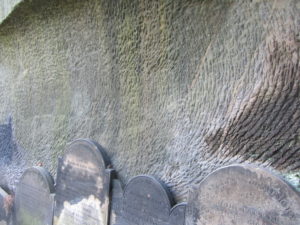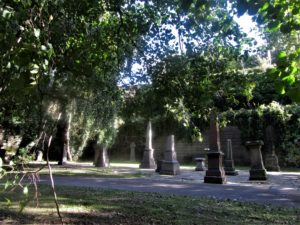As we walked up to Liverpool Anglican Cathedral I drew my husband’s attention to the deep, sunken area between the cathedral and a classical looking, mini Parthenon style building that is now called the Oratory but which originally served as the mortuary chapel. I had noticed this interesting green space during a past visit to Liverpool when I’d had no time to investigate further. My husband peered over the wall and said `it’s just like a Piranasi drawing`; we could see gravestones lining a path and further down what looked like catacombs. We ventured down the path lined with gravestones and through a short tunnel through rock that had been worked on with chisels, making beautiful patterns; the stone is many shades of green, grey, mauve and blue, presumably caused in part by lichen and in places there were tiny ferns. We emerged into a large park-like garden of grass, trees and many gravestones. It was very atmospheric and peaceful with only a couple of dog walkers and runners who looked as if they were regular visitors. It was obviously an old cemetery and then we found an information board that explained more.
This is just a short potted history and there is much more to discover in books and online about this whole area. There was a quarry here from the 17th century and during the 18th century stone from it was used for building much of Georgian Liverpool – there are still many streets of beautiful Georgian terraced houses nearby that escaped the wartime bombing. When all the quality stone was exhausted the disused quarry was developed as a cemetery by the architect John Foster Junior with landscaping by John Shepherd of Liverpool Botanic Gardens. In 1904 building work started on the impressive Anglican cathedral on St James’ Mount next to the cemetery. The cemetery was closed in 1936, by which time almost 60,000 people had been buried there.
Further on there was a domed structure, a mausaleum (Grade 1 listed) built to house a statue of William Huskisson, a statesman and local MP, who became the world’s first recorded rail casualty when he was run over by Stephenson’s Rocket during the opening of the Liverpool and Manchester Railway, a project he had promoted. The marble statue was placed in the mausaleum in 1834 but in 1968 it was vandalised so was removed and given to the National Museums Liverpool Collection. Two other statues of him were made, one is now in Pimlico Gardens in London, and the other at Dukes Terrace, Liverpool. The mausaoeum is looking rather neglected now. A lot of the gravestones were resited in the 1960’s when the central area of the site was landscaped.
Nearby we saw a man drinking water from a spring at the edge of the garden, a sign indicating that it was the Chalybeate (meaning containing iron) mineral water spring. We saw people walking up the ramps on the side of the sandstone cliffs opposite the Cathedral but as we were there to see inside the Cathedral we had no time to investigate further. I’ve since read more about the cemetery and the main entrance is at the other end to the one we used and there is a Lodge, now privately owned, so if I ever go back to Liverpool I will explore further.
St James’ Gardens is Grade 1 listed and well worth a visit; it is free to enter. I’ve only scratched the surface of the history of this garden but for more information “visit the website”:http://www.stjamescemetery.co.uk.









